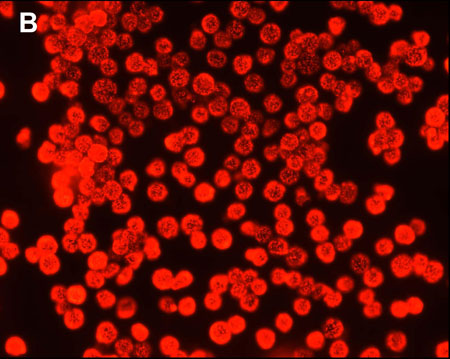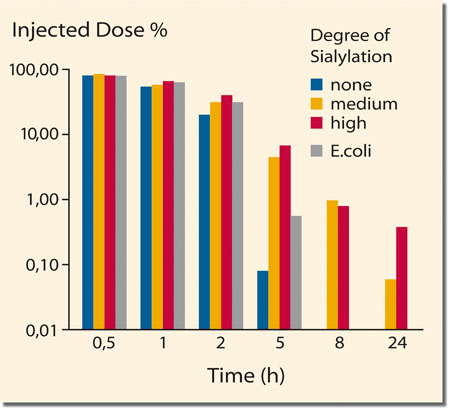Glycosylation can have a big effect on the yields and on the biologic and clinical properties of proteins and vaccines. Hans Baumeister, director clinical immunomonitoring, and Steffen Goletz, ceo, cso and founder of Glycotope, explain how glyco-engineering can be used to optimise their characteristics.
Back when the first therapeutic proteins were developed, glycosylation was largely ignored and glycoproteins were most likely to be excluded from the list of drug candidates. Today, many examples demonstrate that glycosylation not only affects the bioavailability of biopharmaceuticals but strongly influences the activity, immunogenicity, antigenicity, solubility and stability of proteins too.1, 2 Therefore, the aim within the industry is to improve biopharmaceuticals by optimisation and humanisation of their glycosylation and maintain consistency from batch to batch.
Currently, there are at least four suitable approaches:
- Enzymatic modification of the glycosylation after production
- Control of cell culture and production conditions
- Protein engineering to add or eliminate sites for attachment of glycans
- Cell line engineering for a modified glycosylation profile
This article focuses on the small number of companies with novel glyco-engineered cell lines. For example Glycart, acquired by Roche in 2005, and Kyowa (BioWa in the US), which has been part of the Kirin Holding since 2008, developed genetically modified Chinese Hamster Ovary (CHO) cell lines to produce higher active therapeutic antibodies; and GlycoFi (now MSD), Biolex or Greenovation, engineer plant or yeast systems that combine a very high yield with a cost-effective production system using a glycosylation that is similar to a human glycosylation.
Glycotope decided to develop human cell lines with different glycosylation profiles to identify and produce a protein with optimal glycosylation.
fully human glycosylation
Important aspects in modern cell line development are post-translational modifications (PTMs).3 Currently, human bio-therapeutics are produced predominantly in E.coli, yeast or cell lines derived from insects (SF9), mice (SP2/0) or hamsters (CHO). Largely independent of its DNA, a protein’s PTMs, and most importantly the glycosylation, differ from organism to organism and even from cell type to cell type within one organism.
Cell lines of rodent origin confer a glycosylation somewhat similar to a human glycosylation. However, some human components are missing (e.g. the 2,6-linked sialylation) and a number of non-human components have been found to increase significantly the likelihood of immunogenic reactions, such as terminal sialic acids (e.g. NeuGc) or terminal galactose linked to another galactose (Gal-Gal structures).
The latter have been found to be the reason for the clinically observed severe hyper-sensitivity reactions in about 33% of the patients treated with Erbitux. For this reason, human cell lines, such as those of Crucell (Per.C6), Cevec (CAP) or Glycotope (GlycoExpress), have attracted increasing amounts of attention.
In addition, with varying forms of human glycosylation possible, identifying a protein’s optimal glycosylation can result in higher activity, longer serum half-life and improved stability.
To screen for and produce proteins that are glycosylated in such an optimal way, Glycotope engineered its human cell lines to achieve a set of cell lines with different glycosylation profiles.
optimising glycosylation
Today, the conventional technique used involves introducing and/or eliminating a gene relevant for a desired glycosylation profile. For example, GlycoFi knocked-out all genes that are involved in the yeast-specific synthesis of N-glycans and knocked-in the relevant human genes. However, a similar approach proved impossible for O-glycans, because the yeast cells did not survive. At Glycart and Kyowa, CHO cells were glycoengineered to synthesise N-glycans without 1,6-fucosylation, which is important for improving the activity of antibodies.
At Glycotope a number of human cell lines were profiled for the presence of important key structures in the glycosylation, for key enzymes of important glycosylation pathways and for excellent biotechnological characteristics. Cell lines are then glyco-engineered for the desired new glycoprofile while avoiding the generation of a genetically modified organism. All the resulting cell lines exhibit a very stable phenotype (Figure 1).

Figure 1b: Cells stained for a de-sialylated key glycan, analysed after glycoengineering
The cell lines address the 1,6-fucosylation, the 2,3- and 2,6-sialylation, the galactosylation, the antennarity and the presence of bisecting N-acetylglucosamine (see Figure 2). Hence, a given glycoprotein can be produced in absence or presence of 1,6-fucosylation, in absence or presence of 2,3- and 2,6-sialylation, at a very high degree of galactosylation (important for complement dependent cytotoxicity (CDC) activity and to achieve high degrees of sialylation), in presence of bisecting GlcNAc and with antennarities from lower to higher complexity. One cell line has been engineered to sialylate at a very high degree, an important feature to elongate the circulating half-life time. In addition, adjustment of the degree of sialylation or fucosylation to levels between 0% and the naturally possible maximum is possible by means of medium supplementation and in-process control. Hence, a glycoprotein will be available in various glycoforms to identify the particular glycosylation pattern that confers optimal product characteristics.
These two examples illustrate their use:
Glyco-optimisation of antibodies: Therapeutic antibodies are currently an important target for glyco-optimisation because of the remarkable success they have enjoyed in recent years and the observation that glycosylation can affect their activity in vitro and in vivo, namely the antibody dependent cell cytotoxicity (ADCC) and the CDC. Additionally it has been shown that the antibody’s serum half-life and immunogenicity are affected by the degree of sialylation.
One of the essential modes of action of Glycotope’s antibody is to mediate killing of antigen over-expressing tumour cells by ADCC. However, the original antibody is only effective in a subset of maximally 25% of patients in the different populations because of a genetic polymorphism in the FcgIIIa-receptor responsible for mediating the ADCC activity on natural killer (NK) cells. By glyco-optimisation, the antibody’s ADCC activity could be improved up to 250 fold (Figure 2). Hence, the same levels of cytotoxicity can be achieved using 250 times less of the glyco-optimised antibody.

Figure 2: Glyco-optimisation of an antibody
Also, at a given antibody concentration the percentage of killed cells was consistently and significantly higher, with a similar ADCC activity for all three receptor allotypes. In contrast and as expected, the original antibody was only active with one allotype (VV). In addition, the glyco-optimised antibody having a relative high degree of sialylation showed a significantly elongated bioavailability in vivo (data not shown), and based on the fully human glycosylation, no immunogenic reactions against non-human glycans are expected.
Glyco-optimisation of non-antibody glycoproteins: Therapeutic glycoproteins, such as growth factors, glycoprotein hormones, cytokines, certain enzymes, blood factors and thrombolytica, also make good candidates for glyco-optimisation. A growth factor was chosen for glyco-optimisation that is marketed by two pharmaceutical companies. They currently produce this protein in E.coli and yeast that either do not glycosylate at all or glycosylate in a manner lacking any sialylation.
This growth factor was expressed in a cell line that allows production in various degrees of sialylation. Five variants were analysed in a mouse model for determining the bioavailability and in in vitro assays for the bioactivity and compared with one commercial product.
As shown previously,4 the degree of sialylation clearly had a strong impact on the activity, with the highest activity at a high – but interestingly not the highest– sialylation degree. Comparison of increasing concentrations of the optimally sialylated product with the commercially available yeast product revealed that the glyco-optimised product was about 500 times more active than the commercial product.
The level of maximal activity was found to be three times higher than those of the yeast products. When comparing the in vivo half-life, the optimised form was detectable for by far the longest time after injection in mice (Figure 3). Interestingly, the unsialylated (but nevertheless galactosylated) glycoform exhibited a half-life that was even shorter than that of the E.coli product, which is not at all glycosylated.

Figure 3: Improvement of the bioavailability (shown in percentage of injected dose) of a growth factor
Glyco-engineered cell lines chosen for production of therapeutic proteins need to have excellent biotechnical characteristics. CHO cells are the standard mammalian cells for production of biotherapeutics. Therefore novel mammalian cell lines need at least to match CHO cells in productivities and biotechnical characteristics.
Little data is available on whether the glyco-engineered CHO cells of Kyowa and Glycart have kept the same productivities as the original CHO cells. In the case of human cells, Crucell developed a perfusion-based XD process that allowed a much higher cell titer (1.8 x 108 cells/ml) than it is possible with CHO cells and very high antibody yields of more than 10g/L by constant withdrawal of the antibody from the process.
Cell lines of leukemic origin are by nature suspension cells (in contrast to CHO cells) and therefore favourable due to their excellent biotechnical characteristics – such as absence of any viral particles, genetic stability and high shear force resistance. Current productivities of these cell lines amount to around 40 pg antibody/ cell/day under serum-free conditions with cell doubling-times of 14-24h.
Instead of a standard fed batch process used with CHO cells, leukemic cells are very well suited to a perfusion process, which offers advantages when looking to achieve high productivity with highly consistent final product quality. The product is continuously harvested by withdrawal of the cell culture medium and addition of fresh medium. Consequently, the product is constantly removed from the process and is not subject to any metabolism that occurs at 37°C in the fed batch process for about 14 days. Consistently, the products of three independent GMP perfusion runs with a harvest of 3,000 L each revealed identical glycosylation patterns for all three batches. The established perfusion process is characterised by relatively high cell titres of 2 x 107 viable cells/ml and productivities of 2-7g/L bioreactor volume in processes of 20 days.
In 2009, the German and the Italian regulatory authorities approved the use of the first leukemic cell line for production of a biotherapeutic.
In summary, glycosylation has increasingly shifted into the focus of drug development. Its influence on a protein’s characteristics has been acknowledged and a constantly increasing body of evidence, provided in part by Glycotope, justifies the aim of optimisation to achieve higher bioactivity, half-life and lower immunogenicity – essential properties for therapeutic application. Because these improvements provide a high likelihood for IP protection, it is expected that in the near future a number of biotherapeutics will be developed whose therapeutic or economic benefit rests upon properly designed glycosylation.
References
1. Varki A., Biological roles of oligosaccharides: all of the theories are correct, Glycobiology 3, pp97—130, 1993.
2. Kawasaki, N. et al., The significance of glycosylation analysis in development of biopharmaceuticals, Biol. Pharm. Bull. 32,
pp796-800, 2009.
3. Brooks S.A., Appropiate glycosylation of recombinant proteins for human use: implications of choice of expression system. Mol. Biotechnol. 28, pp241-255, 2004,
4. Baumeister H., A novel human expression system for production of higher active biotherapeutics with optimized glycosylation, PharmaChem Biopharmaceuticals 2, pp21-24, 2006.
